- TOP
- Search Criteria
- Ishikawa Brewery: Sake, Beer and Nature on the Outskirts of Tokyo
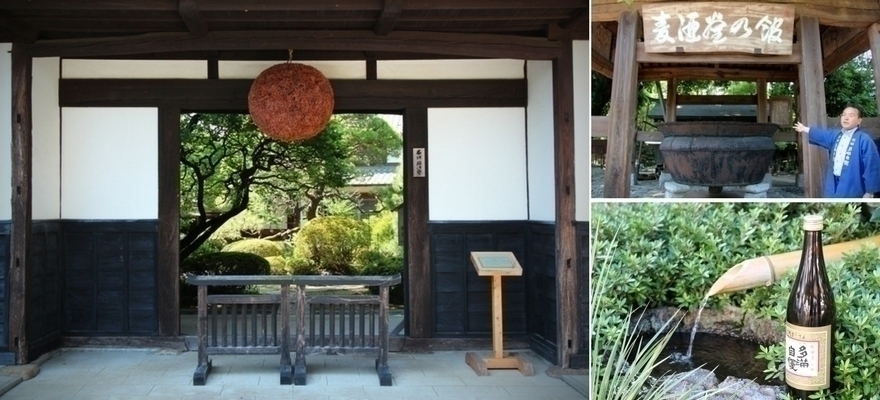
STORY
Ishikawa Brewery: Sake, Beer and Nature on the Outskirts of Tokyo
A sake brewery immersed in nature that houses traditional buildings, a mineral water stream, ancient trees, a massive beer cauldron and an old well. This place must be somewhere deep in the Japanese countryside...or so you thought! This self-proclaimed 'theme park for all sake and beer enthusiasts' is located in Tokyo, about a 50 minute train ride from Shinjuku.
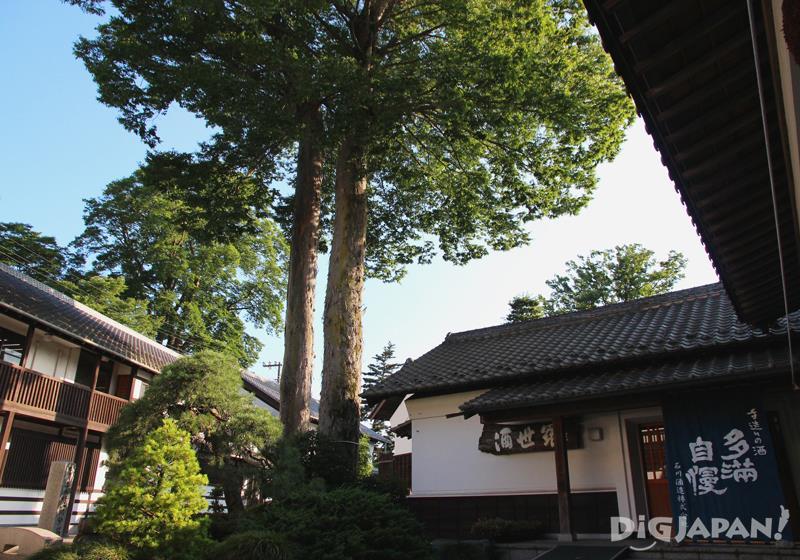
The Ishikawa family is currently at their 18th generation. Established in 1863, Ishikawa Brewery has been brewing their own Tamajiman sake for more than 150 years. In 1887 they also started the production of beer with the name Nihon-Bakushu (Japan Beer). However, since crown bottle caps hadn't been invented yet the production of beer was discontinued after about a year. After the brewing deregulation in 1994 Ishikawa Brewery started brewing beer again in 1998 with a new line called Tama no Megumi.
Brewing sake as well as beer is a quite unique feature, especially because the production of both dates so far back. In addition to that, the traditional buildings and the abundant nature make Ishikawa Brewery more than worth a visit!
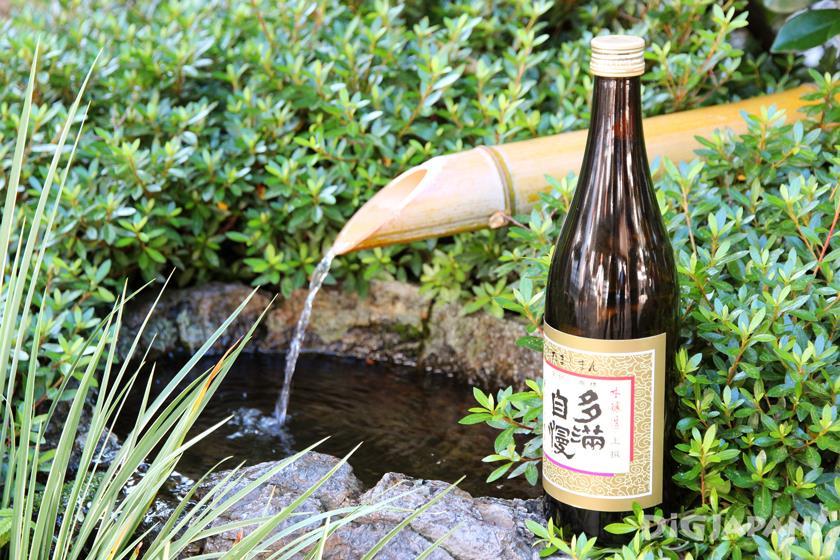
Despite being so close to Japan's biggest metropolis, Ishikawa Brewery set its grounds in a location that is abundant in pure water and fresh air, near the Tama river in the Kumagawa region. Using local natural groundwater they produce their unique sake called Tamajiman, literally 'Tama's pride'. Their craft beer, Tama no Megumi, means 'Tama's blessing'. In 2015 they also released a new line of beer called Tokyo Blues.
There is a water spring on the grounds that everybody can visit. This is the water that they use to brew sake. It's not unusual to see people bringing bottles to take some of the fresh water home.
The tour starts in the main storehouse, built in 1880. Sake is still brewed here in the old buildings with no artificial refrigeration, so they can only make it in the cold months. Inside the kura (storehouse) we were told about how sake is made and other interesting facts about sake brewing.
Above the kura's door is the sugidama, an ornament made of Japanese cedar leaves. By watching the sugidama gradually change color from green to brown, you can tell how long the sake has been left to mature.
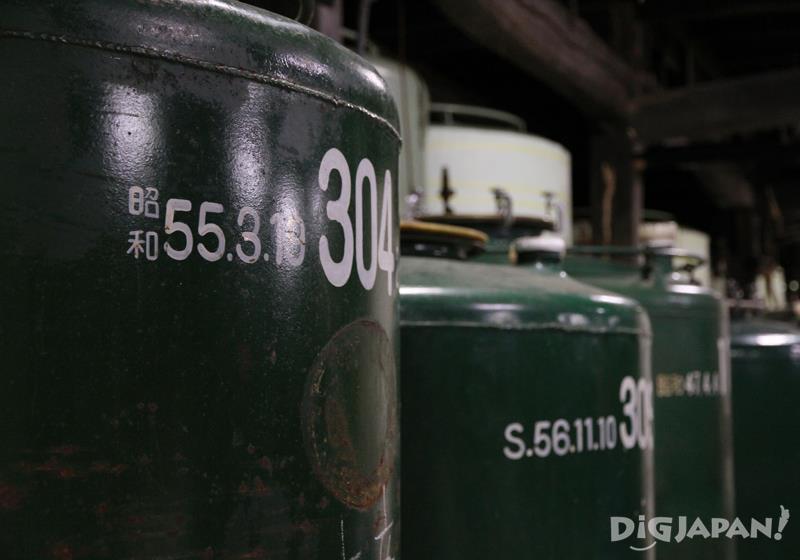
Big sake tanks are stored here. On this one you can see the date of manufacture written in Japanese: March 19th, Showa 55 (1980).
Right next to the main storehouse you can see the spring water used to make sake and beer. Here we could also admire two gigantic 400-year-old zelkova trees.
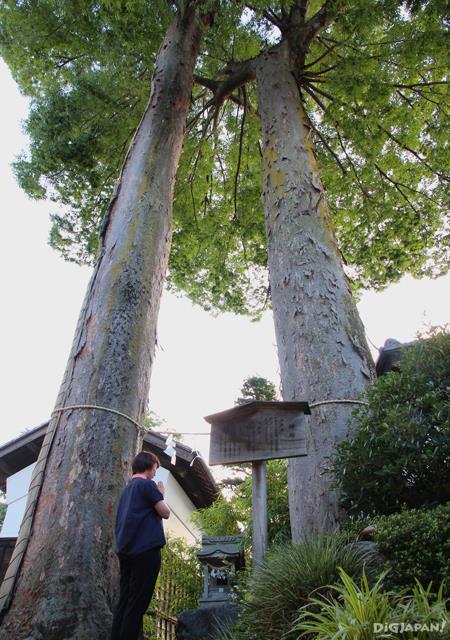
The trees represent the marriage between the god of rice and the goddess of water. Rice and water are the two key ingredients to sake brewing.
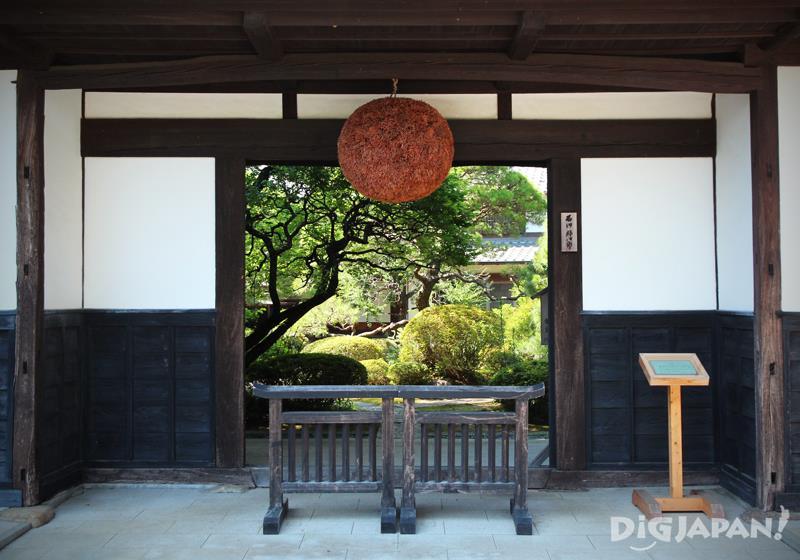
This house gate was built about 250 years ago in the Edo period, before the Ishikawa family started brewing sake. You can see a beautiful garden inside.
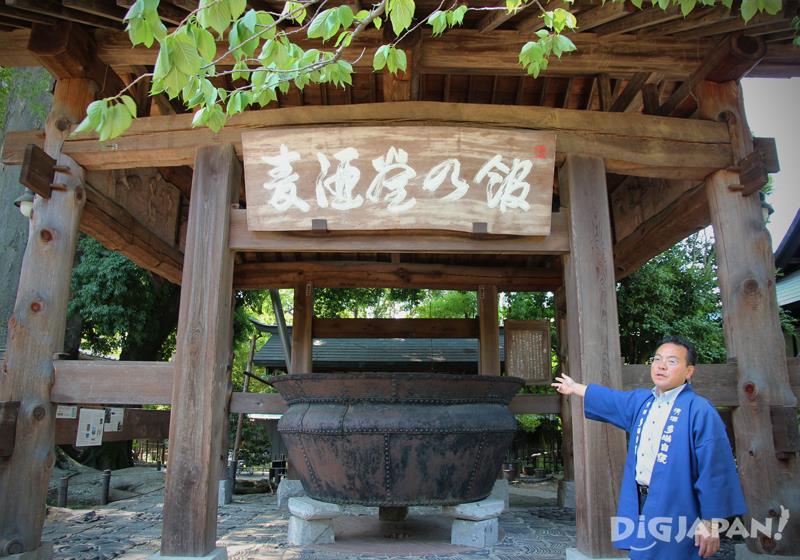
This huge bronze cauldron is the very one that was used to make beer back in 1887 when Ishikawa Brewery first started brewing beer. It miraculously survived the wartime thanks to poor storage care by relatives of the Ishikawa family. They left it in their yard to get buried by plants and this prevented it from being confiscated to supply the war effort.
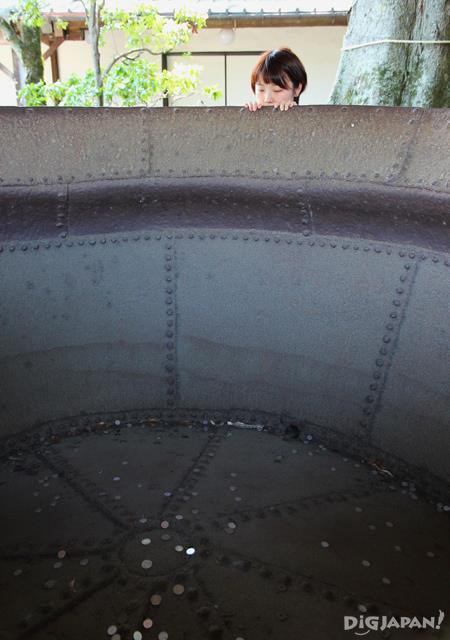
This might give you an idea of how big the cauldron is!
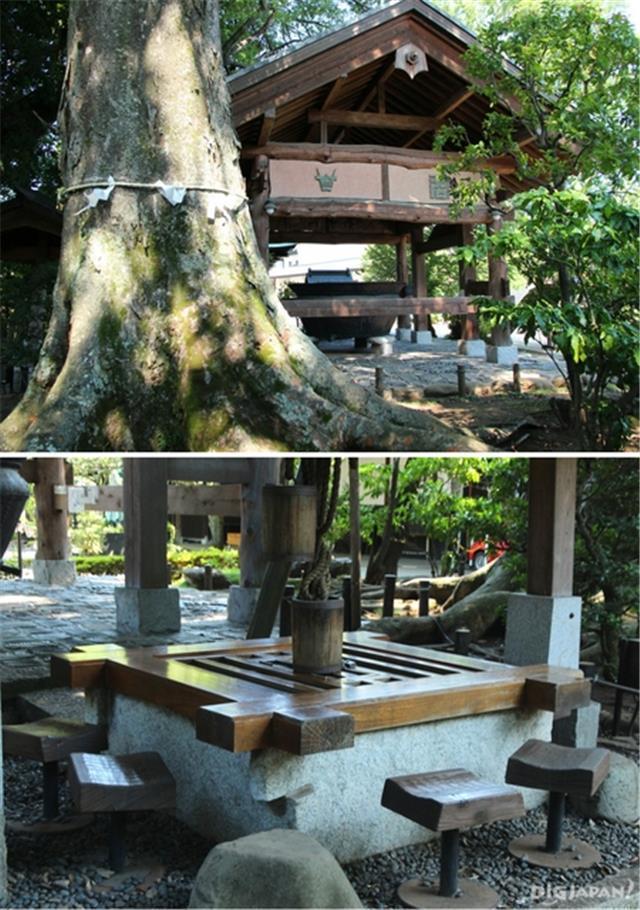
As tradition says, "good water flows under big trees". No doubts about the water being good here, since this well is right at the foot of a 700-years-old sacred tree. You can sit around it and listen to the water dripping inside. This would be my favorite place to enjoy one of Ishikawa Brewery's beers or sake.
The grounds host other kura buildings like the Mukogura where they brew beer, the Bunkogura and the Shingura.
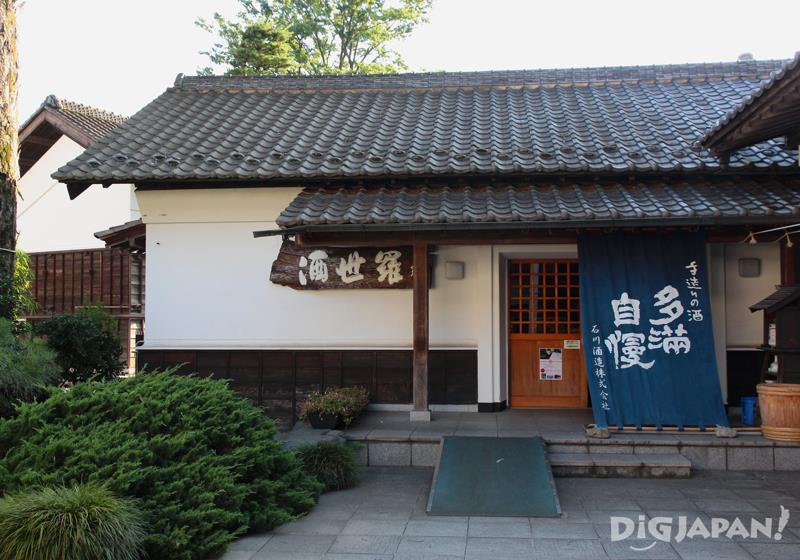
At the end of the tour we enjoyed three kinds of sake in the sake cellar.
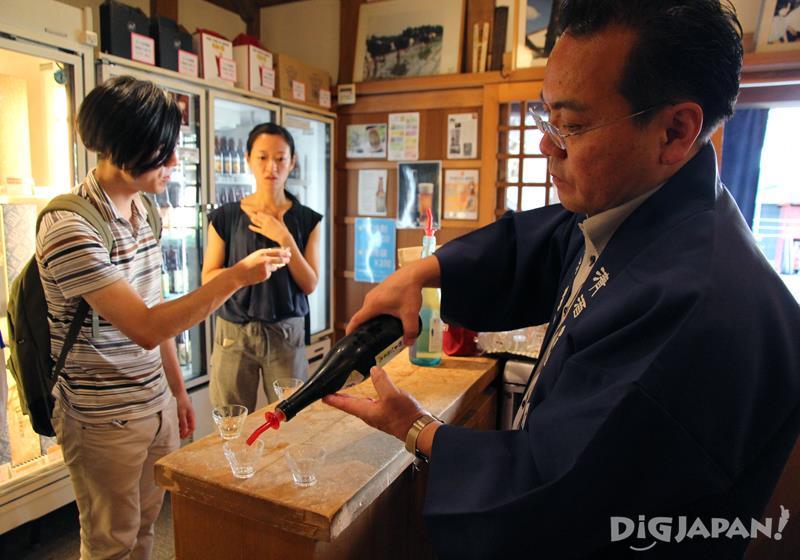
You might get to taste different kinds of sake depending on the season. The servings are really generous and they are all delicious.
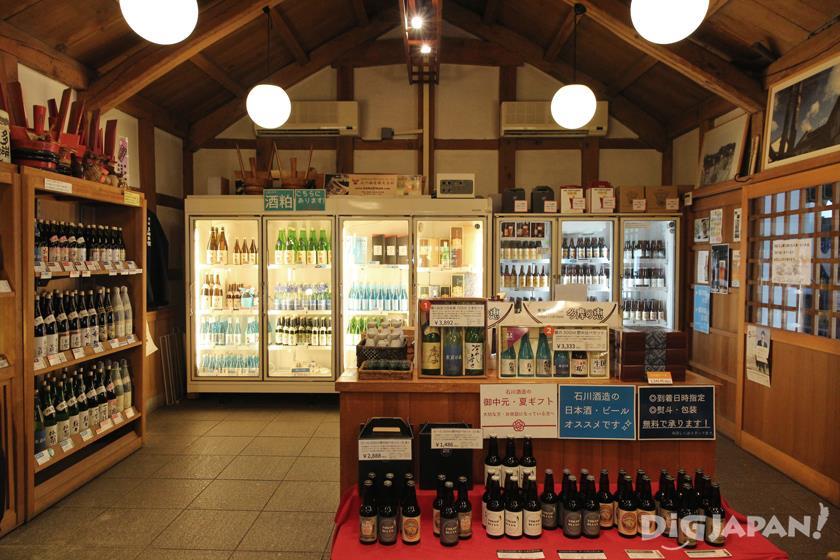
In the cellar is a shop where you can purchase Ishikawa Brewery's sake and beer as well as other sake-based products.
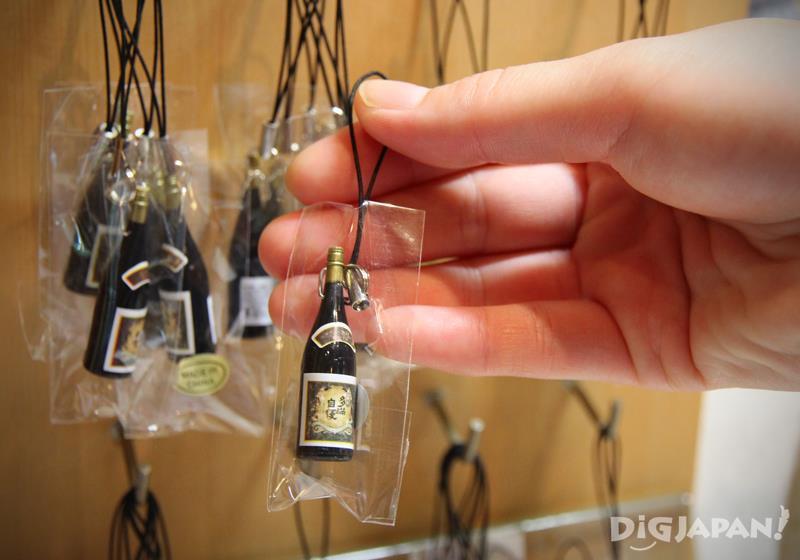
They also have cute souvenirs!
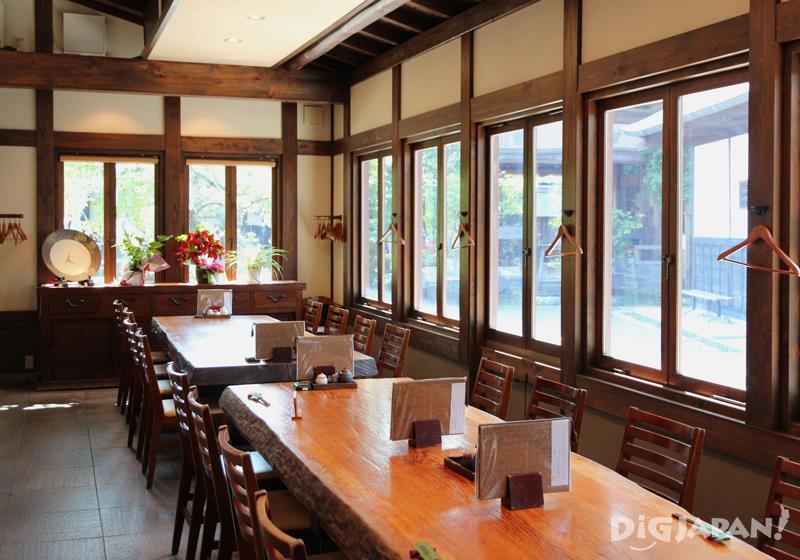
The restaurant is inside a storehouse that was built in 1898.
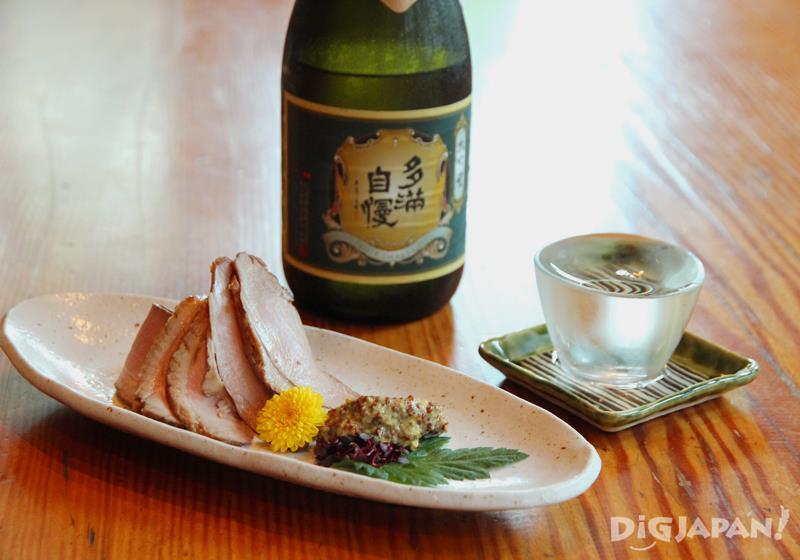
Our first pairing was duck dipped in soy sauce accompanied by Tamajiman Daiginjo, a light and elegant sake with a dry taste.
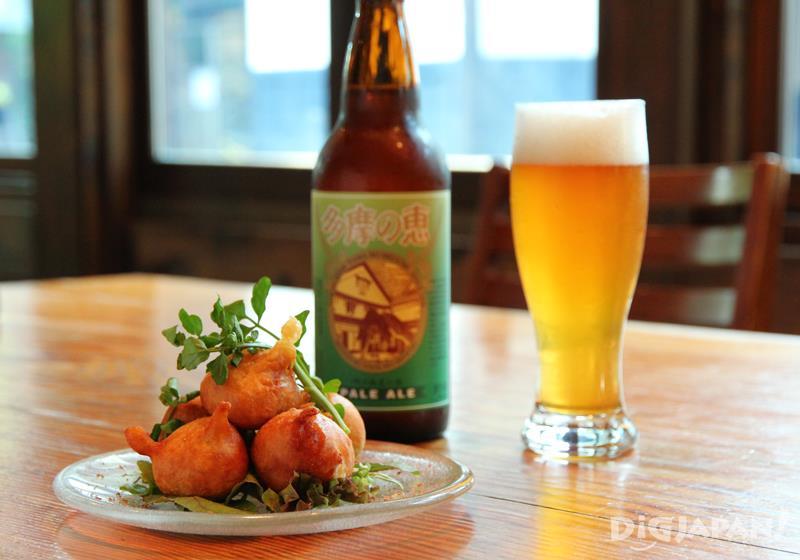
We were also curious about the beer, so we ordered a Tama no Megumi pale ale to wash down a plate of fried cream cheese. The beer had a refreshing taste with a nice hoppy aroma.
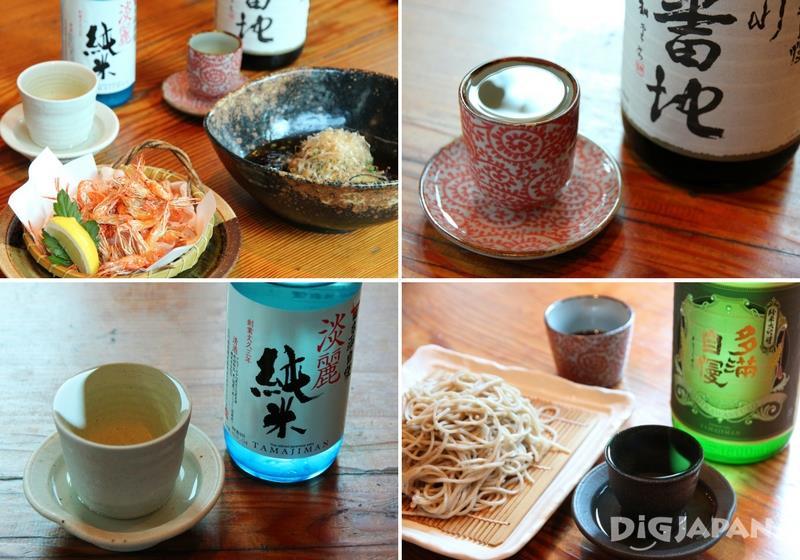
More delicious food and sake ordered by our travel companions!
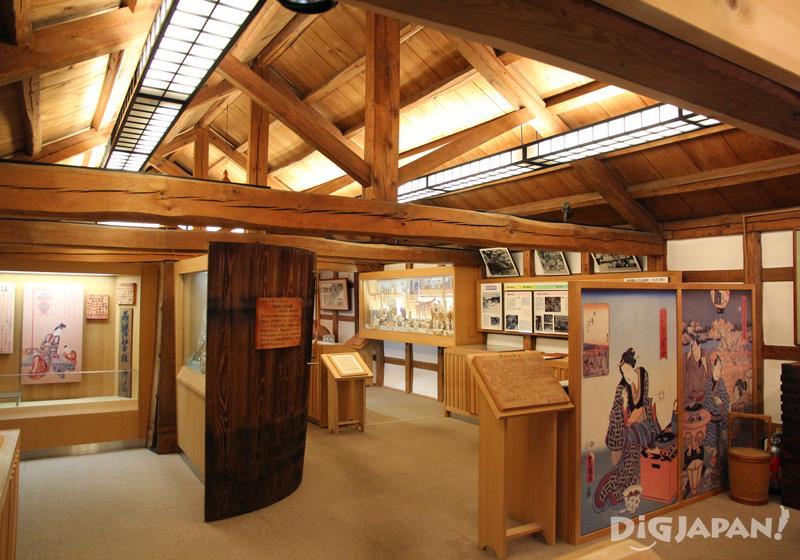
On the restaurant's second floor is a museum that showcases the history of the Ishikawa Family and beer making, as well as sake brewing materials. Entry to the museum is also free of charge.
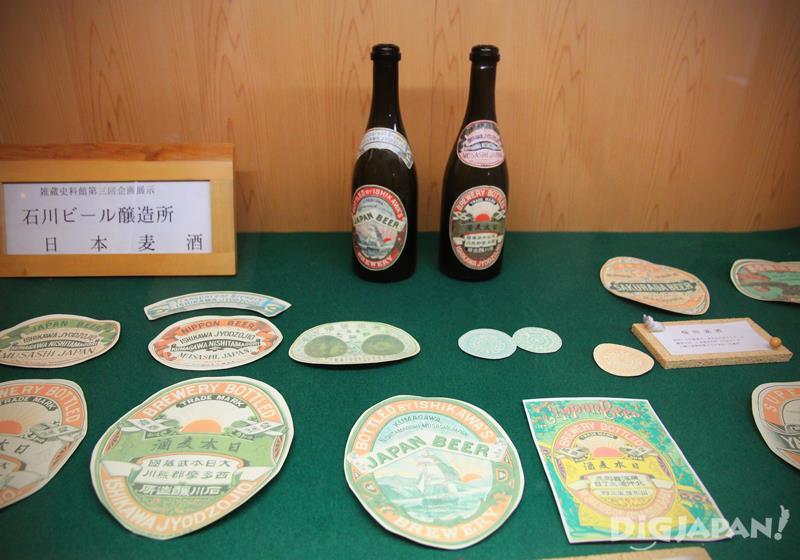
The beer recipe, bottles, and labels used in 1887 are all displayed here.
Make sure you contact them in advance to get a free English tour including sake tasting!
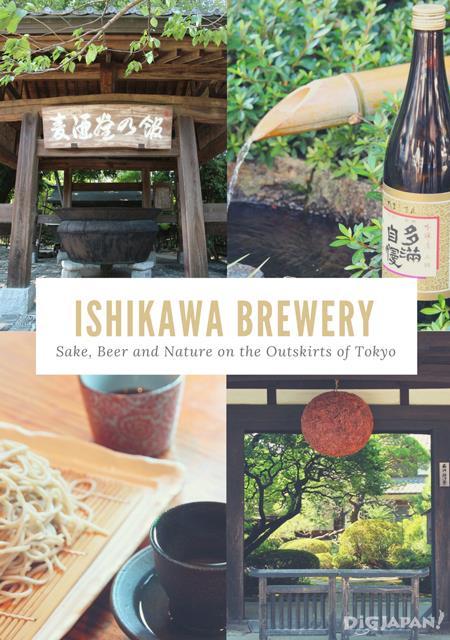
Address: 1 Kumagawa, Fussa-shi, Tokyo
Hours: 8:30am - 5:30pm
Closed on Saturdays, Sundays and National Holidays
Admission fee: Free
Tour duration: approx. 60 minutes
Website: http://tamajiman.co.jp/en/
How to book
E-mail: liveinfo@tamajiman.co.jp
Phone: 042-553-0100 (9:30am-4:00pm)
Guided tours are available in Japanese, English and French.
※ The tour requires a reservation. English tours might not be always available, so be sure to check in advance.
About the author
Laura is an Italian living and working in Tokyo. She loves exploring hidden and unknown places, taking pictures and listening to Punk Rock music. When she’s not busy doing the above, she might enjoy a craft beer or play the sanshin (an Okinawan instrument similar to a shamisen).
Joint photography & interview
SHUN GATE
Shun, in Japanese, refers to the period of time when raw ingredients are in season. Taking inspiration from this concept SHUN GATE is a gate to the stories of the people, techniques, technologies, and the lands that make up Japanese food culture and its seasonal characteristics.
SHUNGATE Website (Ishikawa Brewery):http://shun-gate.com/en/roots/roots_65.html
SHUNGATE facebook:https://www.facebook.com/shungate.en/
A Bit of History

The Ishikawa family is currently at their 18th generation. Established in 1863, Ishikawa Brewery has been brewing their own Tamajiman sake for more than 150 years. In 1887 they also started the production of beer with the name Nihon-Bakushu (Japan Beer). However, since crown bottle caps hadn't been invented yet the production of beer was discontinued after about a year. After the brewing deregulation in 1994 Ishikawa Brewery started brewing beer again in 1998 with a new line called Tama no Megumi.
Brewing sake as well as beer is a quite unique feature, especially because the production of both dates so far back. In addition to that, the traditional buildings and the abundant nature make Ishikawa Brewery more than worth a visit!
Blessed by Nature

Despite being so close to Japan's biggest metropolis, Ishikawa Brewery set its grounds in a location that is abundant in pure water and fresh air, near the Tama river in the Kumagawa region. Using local natural groundwater they produce their unique sake called Tamajiman, literally 'Tama's pride'. Their craft beer, Tama no Megumi, means 'Tama's blessing'. In 2015 they also released a new line of beer called Tokyo Blues.
There is a water spring on the grounds that everybody can visit. This is the water that they use to brew sake. It's not unusual to see people bringing bottles to take some of the fresh water home.
Visiting The Brewery
Ishikawa Brewery offers free tours of the grounds. If you book in advance you'll be able to get a guided tour in English or French, something that very few Japanese breweries offer. The tour includes explanations on how sake is made, a visit of the grounds and sake tasting. Many of the buildings are registered as tangible cultural property in Japan and they are beautiful examples of traditional Japanese architecture.■ Hongura
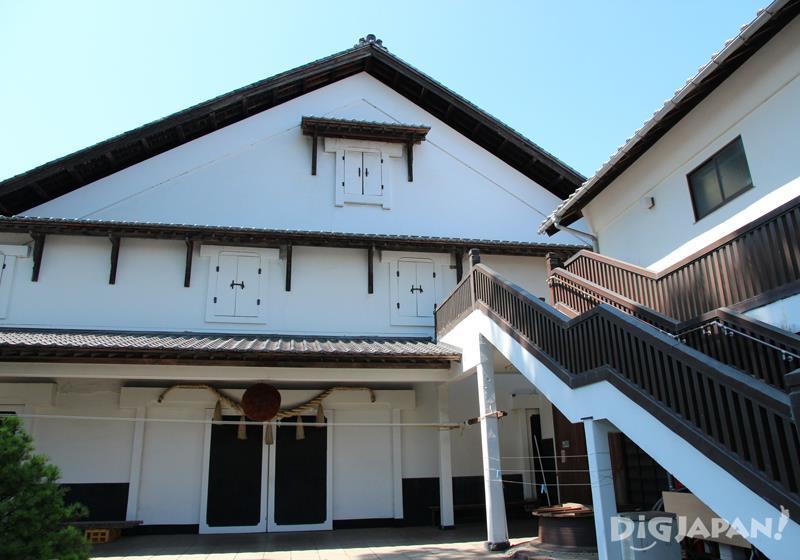
The tour starts in the main storehouse, built in 1880. Sake is still brewed here in the old buildings with no artificial refrigeration, so they can only make it in the cold months. Inside the kura (storehouse) we were told about how sake is made and other interesting facts about sake brewing.
Above the kura's door is the sugidama, an ornament made of Japanese cedar leaves. By watching the sugidama gradually change color from green to brown, you can tell how long the sake has been left to mature.

Big sake tanks are stored here. On this one you can see the date of manufacture written in Japanese: March 19th, Showa 55 (1980).
■Natural Mineral Water and Ancient Trees
Right next to the main storehouse you can see the spring water used to make sake and beer. Here we could also admire two gigantic 400-year-old zelkova trees.

The trees represent the marriage between the god of rice and the goddess of water. Rice and water are the two key ingredients to sake brewing.
■ Nagayamon Gate

This house gate was built about 250 years ago in the Edo period, before the Ishikawa family started brewing sake. You can see a beautiful garden inside.
■ Beer Cauldron House

This huge bronze cauldron is the very one that was used to make beer back in 1887 when Ishikawa Brewery first started brewing beer. It miraculously survived the wartime thanks to poor storage care by relatives of the Ishikawa family. They left it in their yard to get buried by plants and this prevented it from being confiscated to supply the war effort.

This might give you an idea of how big the cauldron is!
■ Water Well

As tradition says, "good water flows under big trees". No doubts about the water being good here, since this well is right at the foot of a 700-years-old sacred tree. You can sit around it and listen to the water dripping inside. This would be my favorite place to enjoy one of Ishikawa Brewery's beers or sake.
The grounds host other kura buildings like the Mukogura where they brew beer, the Bunkogura and the Shingura.
Sake Tasting

At the end of the tour we enjoyed three kinds of sake in the sake cellar.

You might get to taste different kinds of sake depending on the season. The servings are really generous and they are all delicious.

In the cellar is a shop where you can purchase Ishikawa Brewery's sake and beer as well as other sake-based products.

They also have cute souvenirs!
Feeling Hungry? No Need to Look Further
There are two restaurants on the brewery's grounds; Fussa no Birugoya and Zogura. The first is an Italian restaurant where you can enjoy their beer right from the brewery. The latter is a Japanese restaurant specializing in tempura and buckwheat noodles. We chose to try a couple of sake and beer pairings at Zogura.
The restaurant is inside a storehouse that was built in 1898.

Our first pairing was duck dipped in soy sauce accompanied by Tamajiman Daiginjo, a light and elegant sake with a dry taste.

We were also curious about the beer, so we ordered a Tama no Megumi pale ale to wash down a plate of fried cream cheese. The beer had a refreshing taste with a nice hoppy aroma.

More delicious food and sake ordered by our travel companions!

On the restaurant's second floor is a museum that showcases the history of the Ishikawa Family and beer making, as well as sake brewing materials. Entry to the museum is also free of charge.

The beer recipe, bottles, and labels used in 1887 are all displayed here.
How to Get There
Ishikawa Brewery is about a 20 minute walk from Haijima Station. You can get here directly from Shinjuku via the JR Chuo/Ome Line.Definitely Worth a Visit
This brewery has such an interesting history of sake and beer brewing. It really feels like there is a balance between honoring the traditions and opening to new challenges. Its location makes it a perfect one-day or even half-day trip in the nature and fresh air, while remaining in Tokyo.Make sure you contact them in advance to get a free English tour including sake tasting!

Information
ISHIKAWA BREWERY Co.,Ltd. | 石川酒造株式会社Address: 1 Kumagawa, Fussa-shi, Tokyo
Hours: 8:30am - 5:30pm
Closed on Saturdays, Sundays and National Holidays
Admission fee: Free
Tour duration: approx. 60 minutes
Website: http://tamajiman.co.jp/en/
How to book
E-mail: liveinfo@tamajiman.co.jp
Phone: 042-553-0100 (9:30am-4:00pm)
Guided tours are available in Japanese, English and French.
※ The tour requires a reservation. English tours might not be always available, so be sure to check in advance.
About the author
Laura is an Italian living and working in Tokyo. She loves exploring hidden and unknown places, taking pictures and listening to Punk Rock music. When she’s not busy doing the above, she might enjoy a craft beer or play the sanshin (an Okinawan instrument similar to a shamisen).
Joint photography & interview
SHUN GATE
Shun, in Japanese, refers to the period of time when raw ingredients are in season. Taking inspiration from this concept SHUN GATE is a gate to the stories of the people, techniques, technologies, and the lands that make up Japanese food culture and its seasonal characteristics.
SHUNGATE Website (Ishikawa Brewery):http://shun-gate.com/en/roots/roots_65.html
SHUNGATE facebook:https://www.facebook.com/shungate.en/

Liked this story? Like DiGJAPAN!
on Facebook for daily updates!
THIS ARTICLE IS BASED ON INFORMATION FROM 09 06,2017 Author:DiGJAPAN! Editorial Team






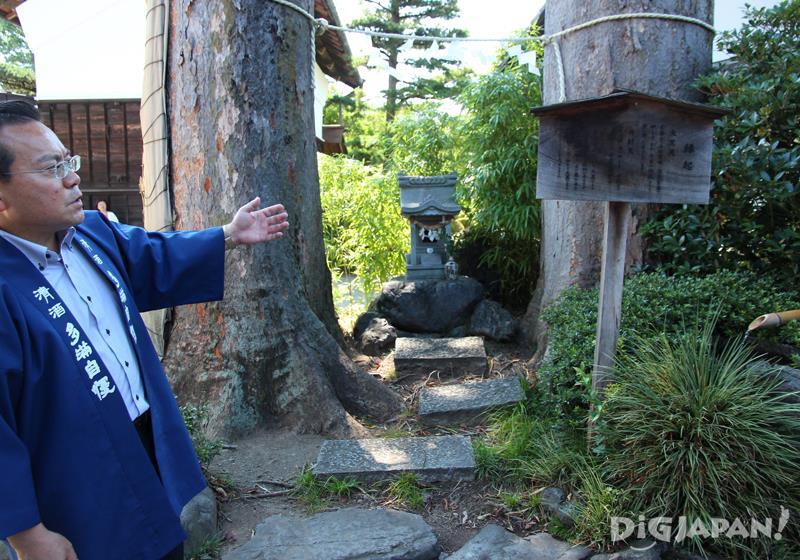







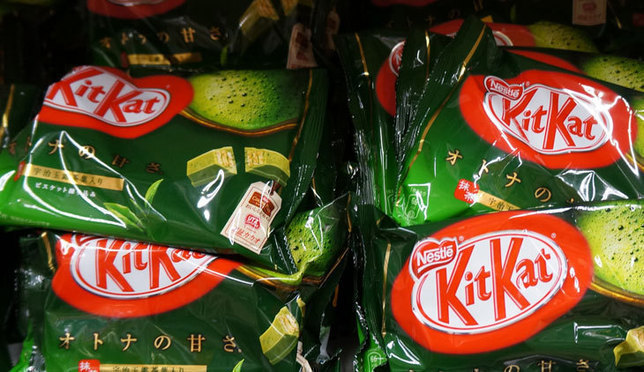
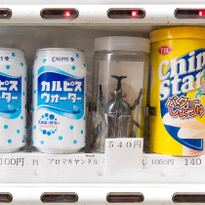
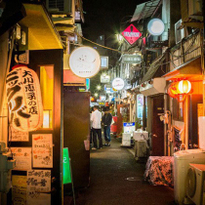
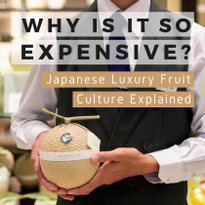
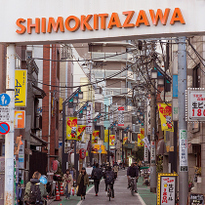




NEW COMMENT | 0 COMMENTS
Open a DiGJAPAN!
account to comment.
Open a DiGJAPAN! Account